Stand Tall Again: Top Posture Correction Tools for Seniors
Why Posture Matters More As We Age
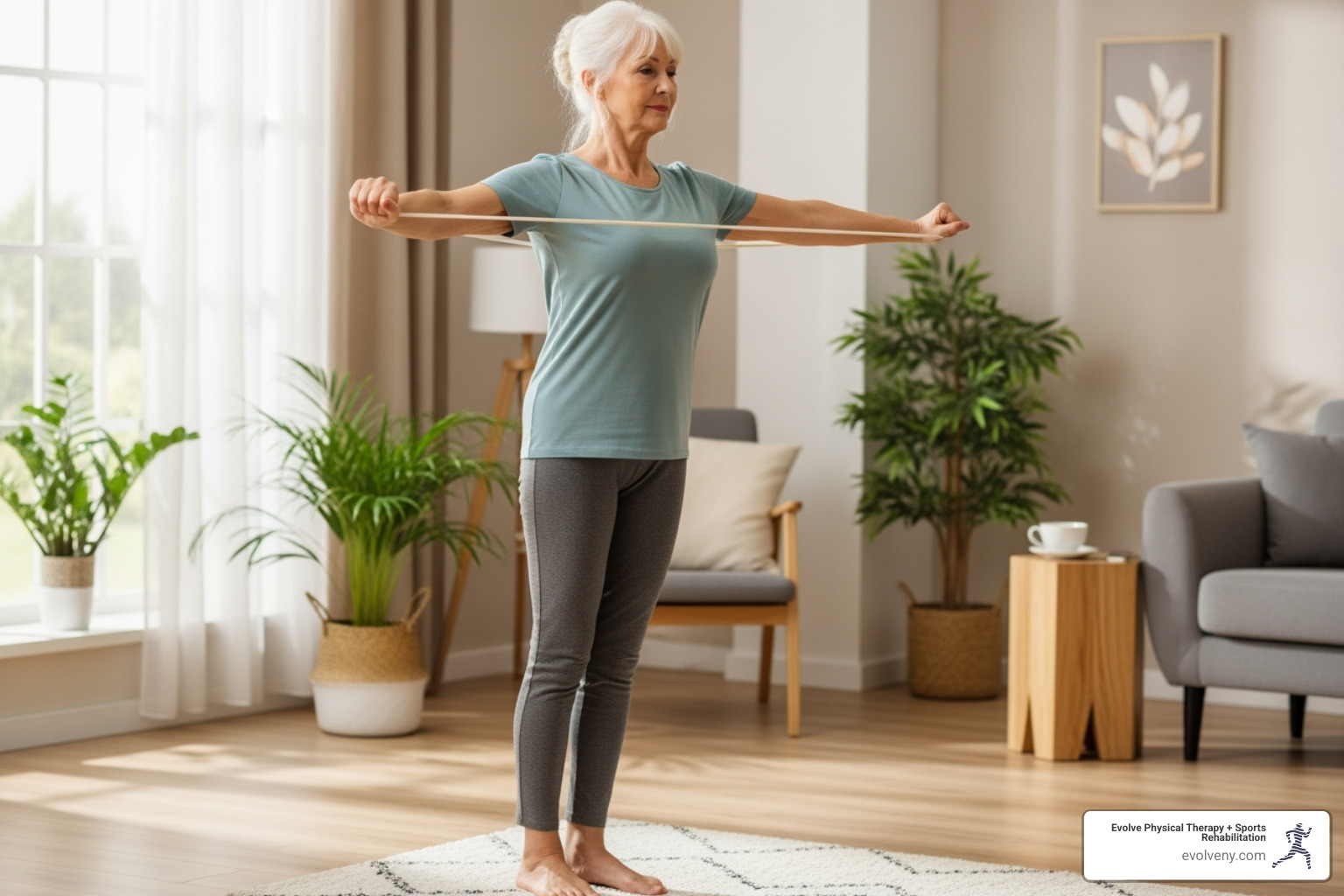
Elderly posture correction is critical as we age. While many seniors accept poor posture as inevitable, maintaining good posture can dramatically improve quality of life, reduce pain, and prevent serious injuries.
Quick answers for elderly posture correction:
- Strengthening exercises: Chin tucks, wall tilts, and scapular squeezes
- Essential stretches: Doorway chest stretches and wall angels
- Daily habits: Take breaks from sitting every 10-15 minutes
- Professional help: Seek physical therapy for persistent pain or severe curvature
- Timeline: Consistent practice shows improvements within 2-8 weeks
Poor posture isn't just about looks; it causes health problems that threaten independence. Slouching shifts our center of gravity, increasing fall risk. A hunched posture also compresses the chest and abdomen, affecting breathing and digestion.
The consequences extend beyond physical discomfort. Seniors with poor posture face:
- Increased fall risk due to altered balance
- Chronic pain in the back, neck, and shoulders
- Reduced lung capacity from chest compression
- Digestive issues from abdominal compression
- Loss of confidence and social withdrawal
Encouragingly, it's never too late to improve your posture. Muscles are adaptable throughout life. With the right exercises and habits, you can stand taller and feel stronger at any age.
I'm Lou Ezrick, a physical therapist with nearly two decades of experience. At Evolve Physical Therapy, I specialize in elderly posture correction using hands-on manual therapy and targeted exercises. I've seen countless seniors improve their posture, reduce pain, and regain confidence with our individualized approach.
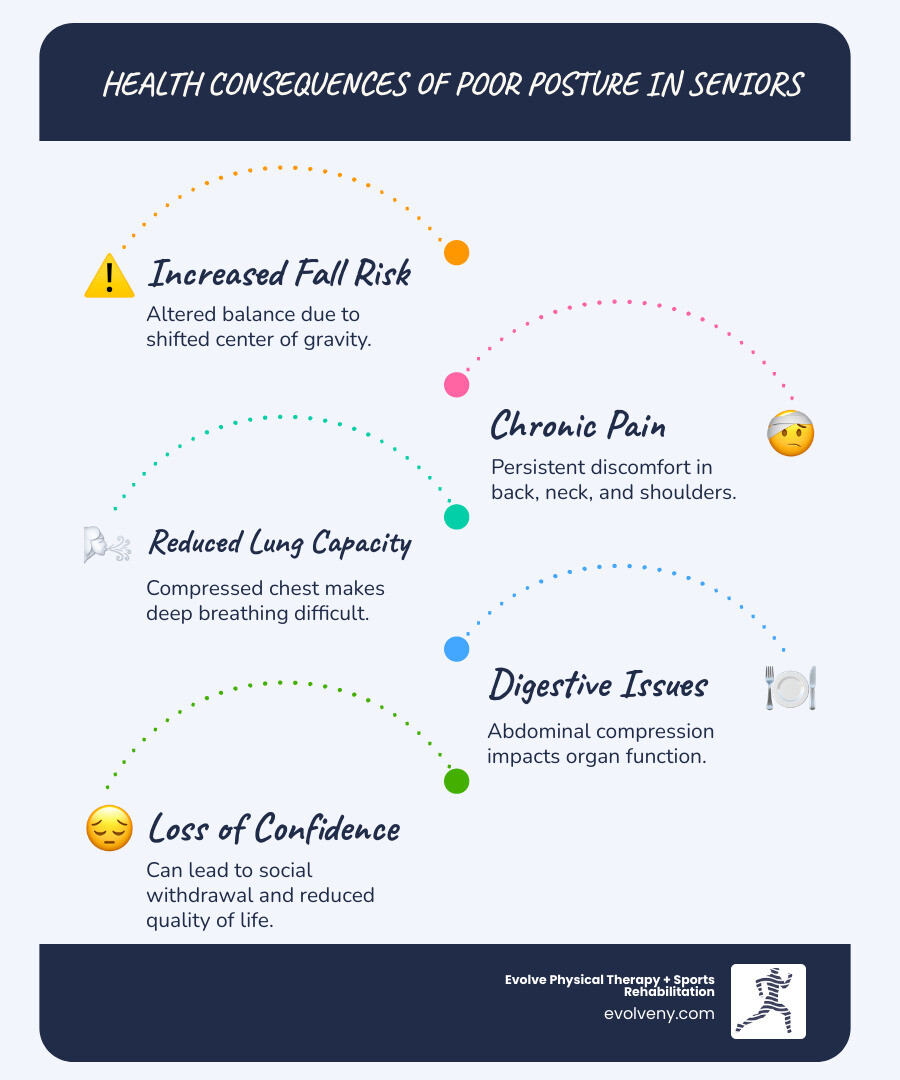
Understanding the Root Causes of Poor Posture in Seniors
Poor posture isn't an inevitable part of aging. While our bodies change, many factors causing a hunched appearance are controllable.
Muscle weakness is a primary cause of poor posture in seniors. Core, back, and shoulder muscles weaken without regular use. When these postural muscles weaken, gravity pulls the body forward into a hunch.
Joint stiffness, especially in the spine, shoulders, and hips, also contributes. Age-related inflexibility can make standing tall uncomfortable or even painful.
Bone density loss is another major concern. Conditions like osteoporosis can cause our vertebrae to become fragile and collapse, leading to compression fractures. This creates the rounded spine condition called kyphosis, sometimes referred to as a "dowager's hump." If you're concerned about bone health, our Physical Therapy for Osteoporosis Brooklyn program can provide specialized support.
Lifestyle factors are significant. A modern sedentary lifestyle contributes to poor posture. Spending hours sitting shortens hip flexors and tightens chest muscles, pulling shoulders forward. Habitual slouching while watching TV or using phones reinforces these poor positions.
Spinal changes, like the natural compression of spinal discs with age, also contribute to a forward-bent posture. However, targeted exercises and proper body mechanics can slow these changes.
Understanding these root causes is the first step toward effective elderly posture correction. Muscles can be strengthened, joints can regain flexibility, and habits can be changed at any age. If muscle weakness is a concern, our Physical Therapy for Muscle Weakness program offers targeted solutions.
For those interested in the science, this study on posture changes with age provides insights into how our posture evolves.
The Connection Between Posture, Balance, and Fall Prevention
Your posture directly affects your balance, which in turn determines your fall risk.
Good posture ensures your center of gravity is stable, allowing for quick reactions to balance threats. But when posture deteriorates—think hunched shoulders and a forward head—your center of gravity shifts forward. This makes you fight gravity just to stay upright.
This shift dramatically increases your risk of falls. Research shows that seniors with poor posture are more likely to fall and suffer serious injuries, which can lead to a loss of independence.
Improving your posture significantly reduces this risk. Better posture leads to better balance and more confidence in daily movements like walking, getting up from chairs, and navigating stairs.
Maintaining independence is the ultimate goal. Moving confidently and safely allows you to retain control over your life and continue your favorite activities.
At Evolve Physical Therapy, our Physical Therapy for Fall Prevention Brooklyn program specifically addresses the posture-balance relationship. We also offer comprehensive Balance Training for Seniors that works hand-in-hand with posture correction.
Foundational Exercises and Stretches for Better Posture
For elderly posture correction, we must strengthen loose, weak muscles and stretch tight, shortened ones. Posture improvement requires balancing muscle groups. Your core provides stability, back muscles pull your shoulders back, and chest muscles, often tight from hunching, need stretching.
Consistency is key. Just 15-20 minutes of focused, regular exercises can create remarkable changes in how you stand, move, and feel. These gentle yet powerful exercises are designed for seniors and can be done at home with little to no equipment.
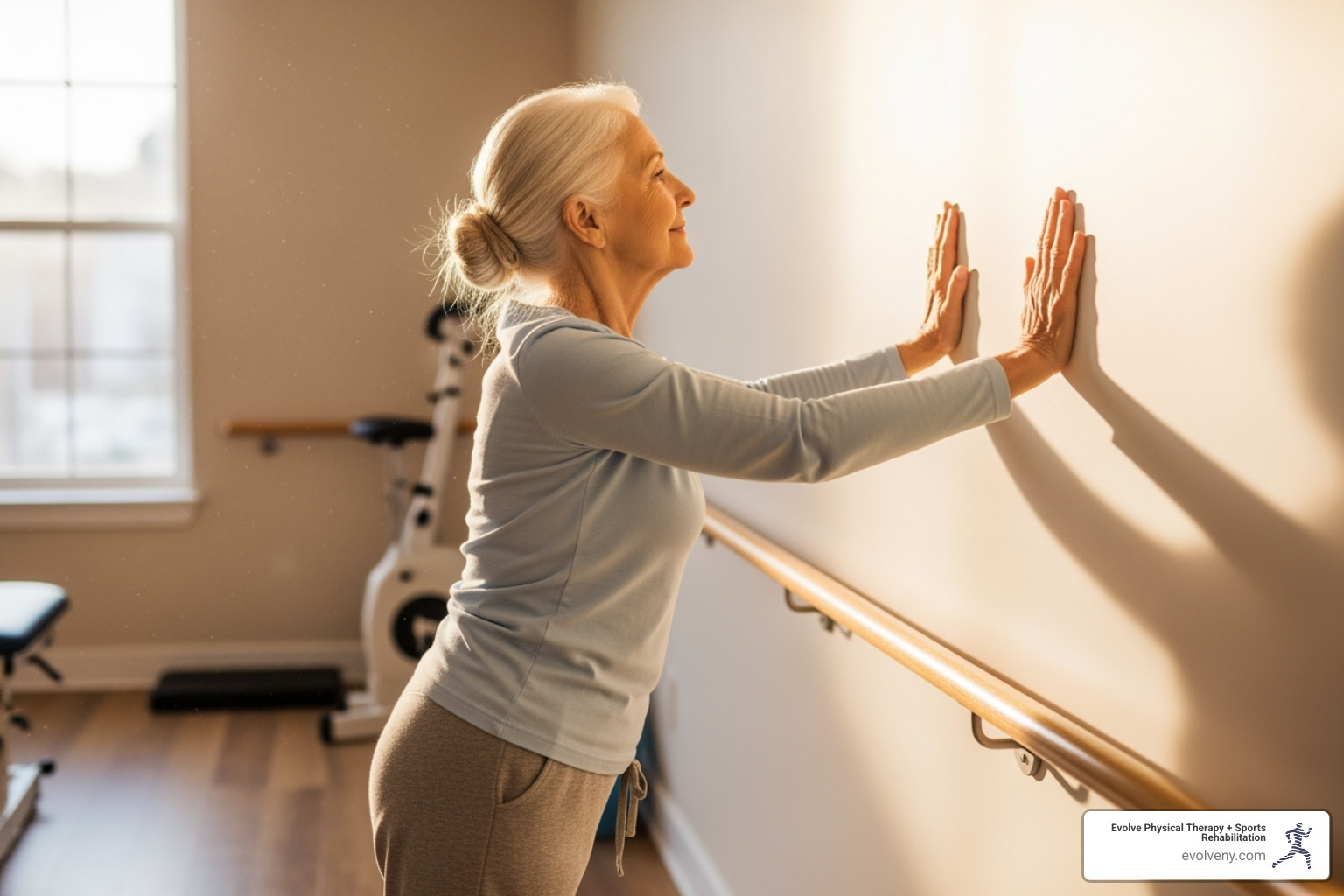
Strengthening Exercises for Elderly Posture Correction
Here are five effective strengthening exercises for elderly posture correction, each targeting specific weak muscles.
Chin tucks combat forward head posture. Sit comfortably and gently pull the back of your head straight back, creating a long neck without looking up or down. Hold for five seconds, feeling the deep neck muscles work. Repeat ten times.
Wall tilts strengthen your core. Stand with your back against a wall, feet six inches away. Pull your belly button toward your spine and tuck your tailbone to press your lower back flat against the wall.
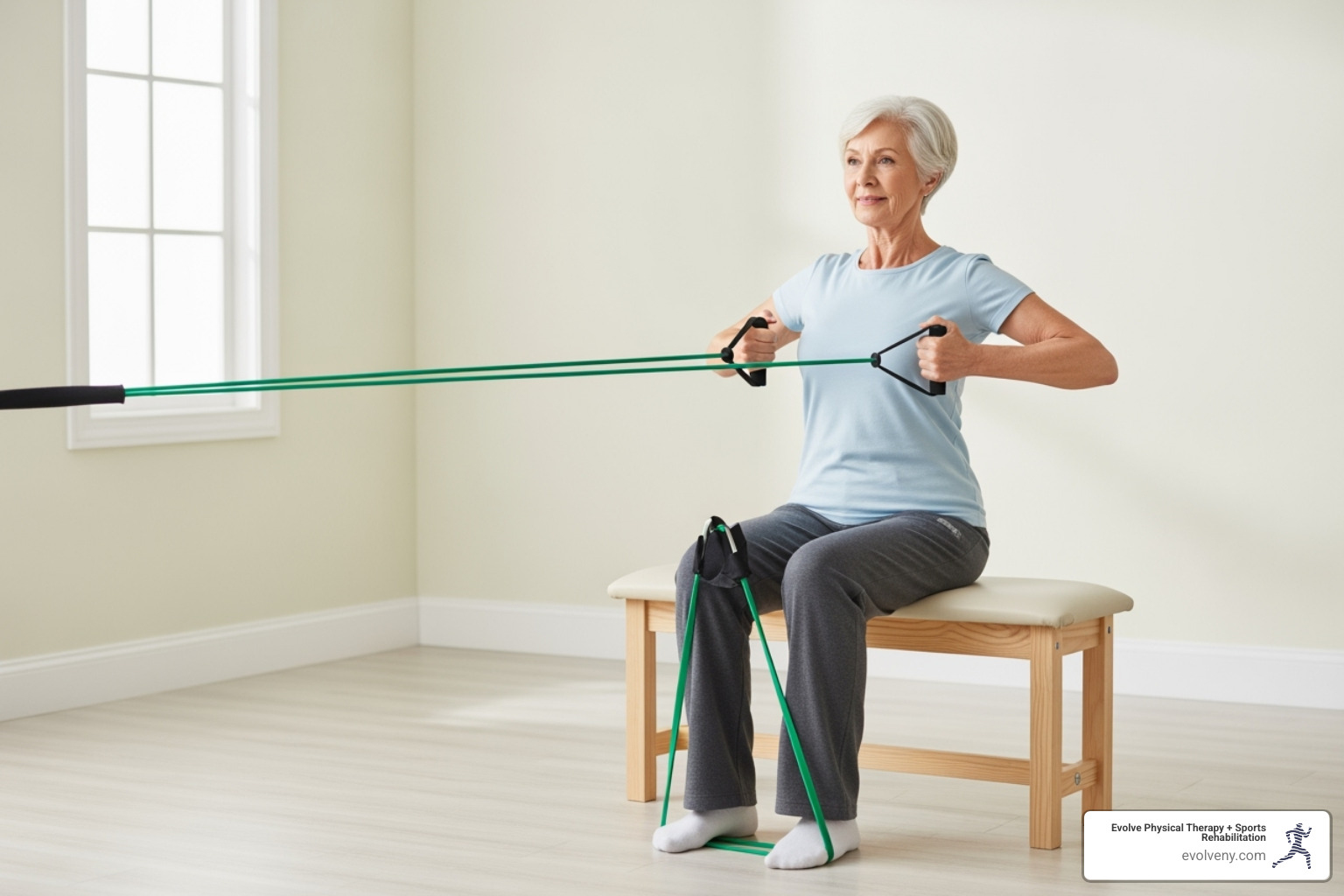
Scapular squeezes target rounded shoulders. Imagine squeezing a tennis ball between your shoulder blades. Keep shoulders down and back, hold for five seconds, then release.
The bird dog exercise is effective for core stability. Start on your hands and knees. Slowly extend one arm forward and the opposite leg back, keeping your back flat and core engaged.
Bridges strengthen your glutes and hamstrings. Lie on your back with knees bent. Lift your hips to create a straight line from shoulders to knees.
A seated row with a resistance band is perfect for adding resistance. The pulling motion directly counteracts forward hunching. For more on how physical therapy addresses joint health, see our guide on Physical Therapy for Degenerative Joint Disease.
Essential Stretches to Counteract a Hunched Back
Strengthening is crucial, but we must also stretch tight muscles that pull you into poor posture. These stretches target areas shortened by forward head posture and rounded shoulders.
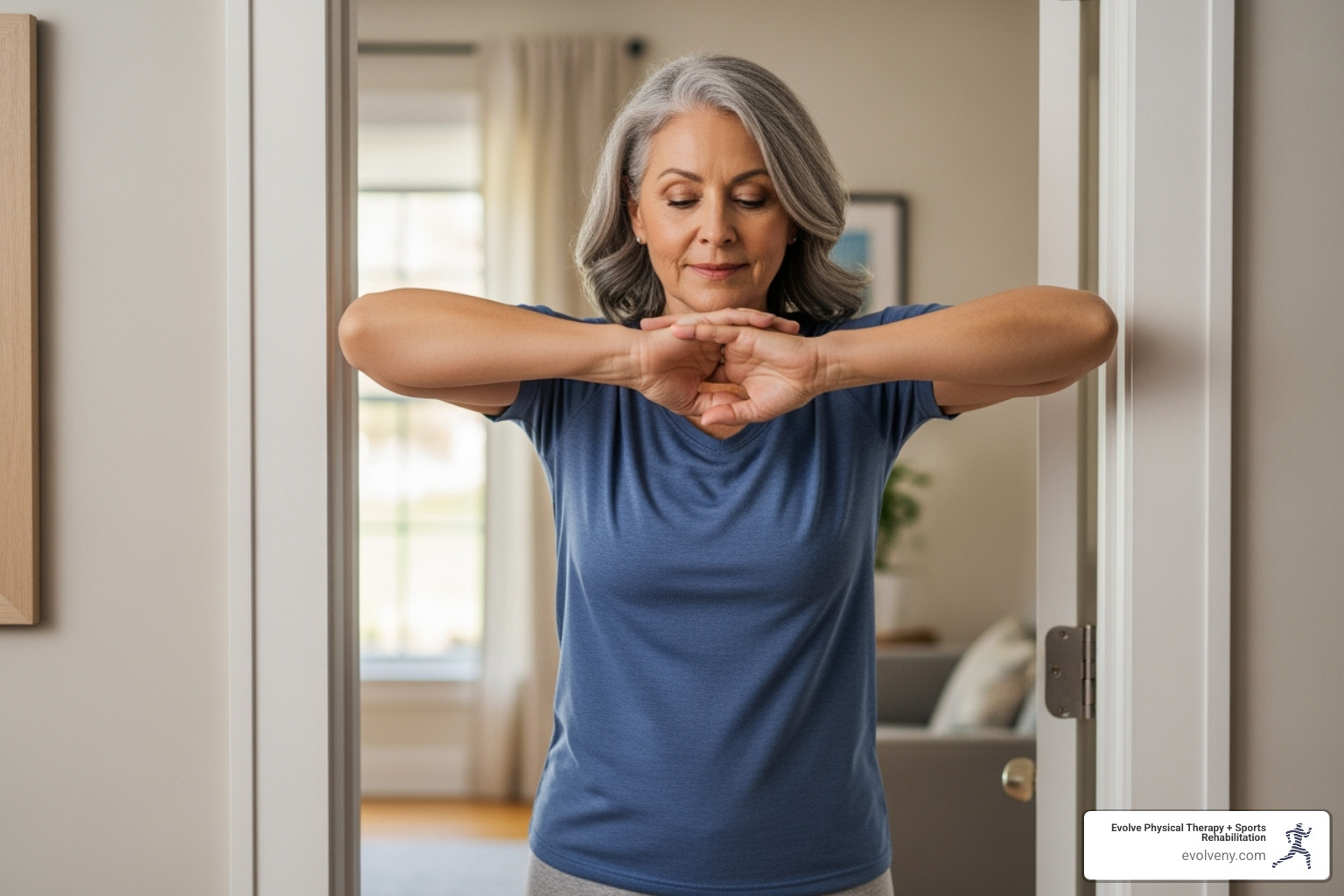
The doorway stretch is transformative for a tight chest. Stand in a doorway with your arms in a "cactus" position (elbows bent at 90 degrees, palms on the frame). Step one foot forward and lean gently into the stretch. Hold for 20-30 seconds.
A seated chest stretch can be done anywhere. Clasp your hands behind your back (or use a towel) and gently lift them away from your body to open up tight chest muscles.
Wall angels are like making snow angels against a wall. Stand with your back flat against a wall. Slowly slide your arms up and down, keeping elbows and hands on the wall.
Don't forget neck stretches. Gently tilt your head, bringing your ear toward each shoulder. To stretch the back of your neck, tuck your chin and look down slightly.
All stretches should feel gentle, not painful. For additional exercises, the Cleveland Clinic offers some excellent exercises to improve your posture.
Helpful Tools and Lifestyle Adjustments
Better posture requires more than exercise; it's a lifestyle change. Small, daily adjustments to your environment and habits can lead to remarkable improvements in elderly posture correction.
Ergonomics is about creating spaces that encourage proper alignment, so your surroundings support you. Daily habits, like slouching while watching TV or craning your neck to use a phone, shape our bodies. Developing self-awareness about your posture is the first step to improvement.
Supportive furniture is a game-changer. Choose chairs with good lower back support that let your feet rest flat on the floor. A simple lumbar cushion can improve existing chairs. Proper footwear with good arch support is your body's foundation, helping maintain alignment from the ground up.
How Evolve Physical Therapy Supports Posture Correction for Seniors
At Evolve Physical Therapy, effective elderly posture correction begins with a thorough assessment. We identify your unique challenges and goals to understand the specific causes of your posture concerns.
Our hands-on approach involves showing and guiding you. We find practical solutions like the use of supportive cushions and ergonomic adjustments for your home. We provide guidance on safe, effective posture strategies that become second nature, teaching you to engage your core, lift safely, and find a comfortable, natural posture.

Knowing when to seek professional advice is key. If you have persistent pain, significant spinal curvature, or see no improvement from home efforts, our expertise is invaluable. We specialize in complex postural challenges, including those related to conditions like osteoporosis or past injuries. You can explore our Information on posture support options at Evolve Physical Therapy.
Lifestyle Adjustments for Lasting Elderly Posture Correction
Powerful changes come from daily habits that naturally support better posture.
Mindful sitting is key. Sit with your feet flat on the floor, back supported, and head held high. At a computer, keep the screen at eye level to prevent forward head lean. For more tips, see our guide to Correct Computer Posture.
Walk with intention: gaze forward, let your arms swing naturally, and think tall. Maintaining an aligned posture makes every step count.
Breaking up sedentary time is one of the most effective strategies. Our bodies aren't meant to be still for hours. Set a reminder to move every 30 minutes; even a brief stand and stretch helps.
Your proper sleeping positions also matter. For side sleepers, use a pillow between your knees. For back sleepers, a small pillow under the knees can reduce lower back strain.
Finally, hydration and nutrition are the building blocks for strong muscles and bones. Protein, calcium, and vitamin D are essential, and proper hydration keeps tissues supple.
When to Seek Professional Help for Posture Problems
While home exercises and mindful habits are effective, sometimes professional help is necessary to address deeper issues. The key is recognizing when your posture problems have moved beyond the "do-it-yourself" category.
Chronic pain that persists in your back, neck, or shoulders and interferes with daily life or sleep is a clear sign to seek help. Never ignore numbness or tingling in your arms, hands, or legs, as this may indicate nerve compression. Severe curvature of the spine, especially if it's worsening rapidly, also requires prompt professional evaluation.
After a fall or injury, it's wise to have a professional assessment, as it can cause subtle changes that lead to future posture problems. Also, seek help for difficulty breathing, which can be caused by a hunched posture compressing your chest.
If home exercises aren't enough after several weeks, it's time for a personalized approach. Every body is unique and may require a different solution.
How a Physical Therapist Can Help
At Evolve Physical Therapy + Sports Rehabilitation, our approach to elderly posture correction is both an art and a science. We go beyond telling you to "stand up straighter" by identifying the unique factors causing your posture issues.
Everything starts with a personalized assessment. We examine your movement, muscle strength, joint stiffness, and balance. This evaluation allows us to create a treatment plan that addresses your specific needs.
Our manual therapy techniques are a cornerstone of our hands-on philosophy. Using skilled touch, we can help release tight muscles, improve joint mobility, and reduce the tension pulling your body out of alignment.
We then develop custom exercise programs based on your assessment. We teach proper form and progression for maximum benefit and safety, unlike generic online exercises.
Pain management is often a crucial part of treatment. We use various techniques to reduce discomfort, allowing you to focus on your rehabilitation.
Our body mechanics education provides a deep understanding of how to move and position your body daily. We teach you how to get out of chairs, lift safely, and maintain good posture during all activities.
At Evolve Physical Therapy, we believe in empowering you with skills that last a lifetime. When you're ready to take the next step, you can learn more about our services at Physical Therapy for Seniors in Brooklyn.
Frequently Asked Questions about Elderly Posture Correction
At Evolve Physical Therapy, I often discuss posture with seniors. Their questions reflect real concerns about aging and independence. Here are answers to the most common questions to provide clarity and encouragement.
Is it ever too late to improve my posture?
The answer is a resounding no, it's not too late! I've worked with patients in their 80s and 90s who have made remarkable improvements in their posture and well-being.
Science shows that muscle adaptability doesn't have an expiration date. Your muscles respond to exercise throughout life. The process might take longer as we age, but the body's capacity for positive change remains.
One 78-year-old patient was convinced she couldn't improve. Three months later, she stood taller, slept better, and had less back pain. Small improvements make a big difference; the goal is better alignment, less pain, and more confidence, not perfection.
The key is consistency. Show up for yourself regularly and trust the process.
How long does it take to see results from posture exercises?
The timeline for results varies per individual, depending on your starting point, the severity of postural changes, underlying conditions, and consistency.
Typically, patients notice initial improvements in comfort and awareness within 2 to 4 weeks. You might experience less backache or find yourself naturally correcting your slouch.
Visible changes often appear after 2 to 3 months with consistency over weeks and months. However, focus on feeling better, not just looking different. Reduced pain, improved breathing, and easier movement are often the first and most meaningful changes.
Elderly posture correction is a journey, not a destination. Every day you practice is an investment in your long-term health.
Can poor posture affect my breathing and digestion?
Yes, absolutely! Your posture directly impacts how well your internal organs can function, a "hidden" consequence that affects your quality of life.
A hunched posture compresses the chest and restricts lung expansion, making it harder to breathe deeply. You might feel short of breath or take shallower breaths. Improved posture often resolves this.
Similarly, a forward, hunched position compresses abdominal organs. This can affect digestion by interfering with the natural movement of food, which may cause bloating or discomfort. These issues often improve as posture gets better.
Good posture gives your organs the space they need to function properly, while poor posture puts them in a cramped position all day long.
Conclusion: Take the First Step Towards Standing Taller
We've learned that elderly posture correction is about living better, not just looking better. Poor posture impacts breathing, balance, confidence, and independence. Most importantly, we've learned that it's never too late to make meaningful changes.
The benefits of improving your posture are extensive. Standing taller helps you breathe easier, move confidently, and significantly reduce your risk of falls. It also improves digestion, diminishes chronic pain, and empowers you to take control of your health.
This is about proactive health. Every exercise and moment of mindful sitting is an investment in your future, improving your current quality of life and building a foundation for lasting independence and vitality.
It's a journey, not a destination. Consistency is key, and small daily choices lead to significant change. Be patient with yourself, celebrate small victories, and trust in your body's remarkable ability to adapt and improve.
At Evolve Physical Therapy + Sports Rehabilitation, our hands-on approach has helped countless seniors transform their posture and confidence. We provide the personalized support and expert guidance you need for your unique journey.
Don't let poor posture define your golden years. You have the power to stand taller, move better, and feel stronger. Whether you're just beginning to notice posture changes or you've been struggling with chronic pain, professional help can make all the difference.

